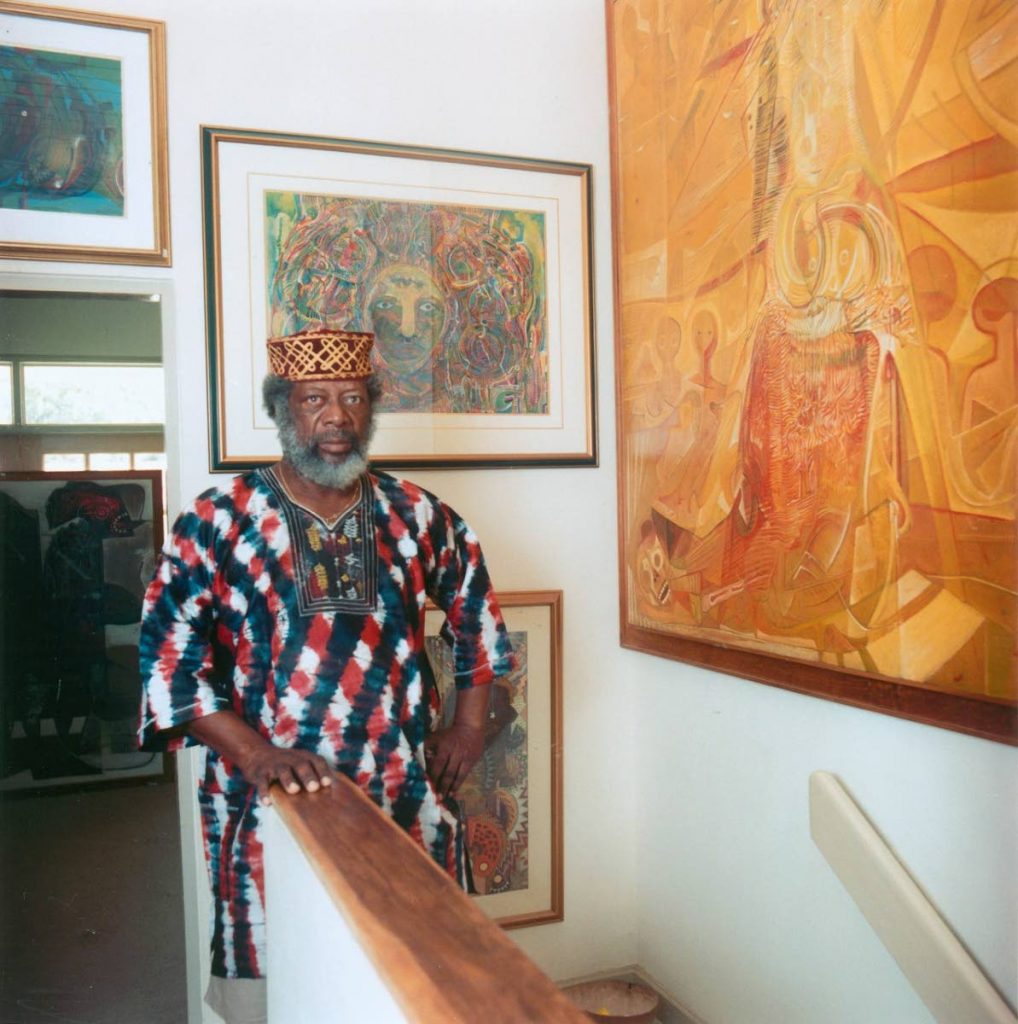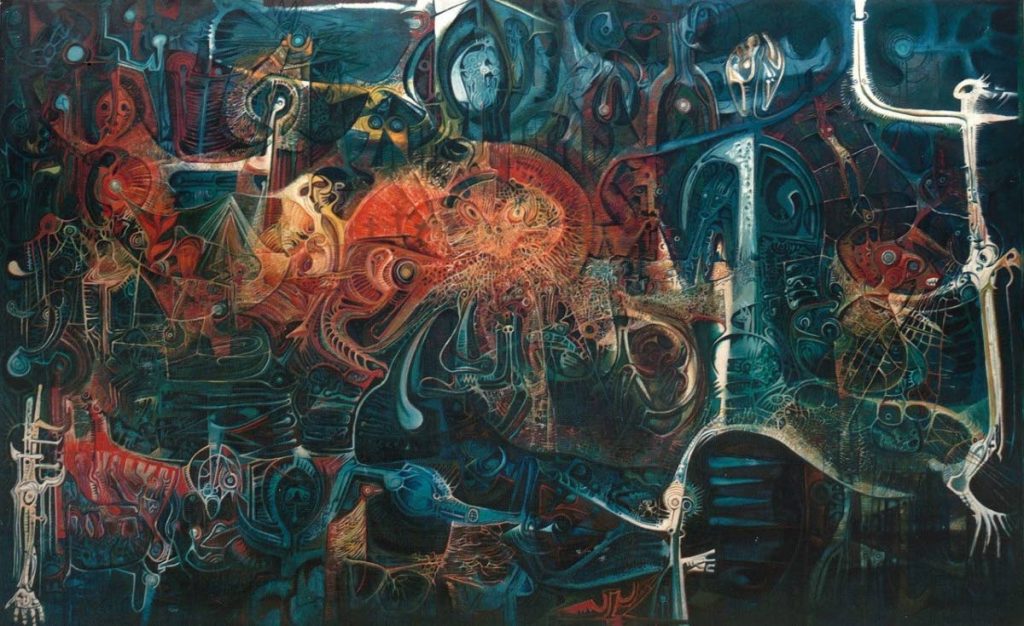Artists pay tribute to LeRoy Clarke

THE death of artist, poet and national icon LeRoy Clarke on Tuesday has undoubtedly left a void in the creative landscape of Trinidad and Tobago.
Clarke, 82, was born in Belmont in November 1938 and most recently lived in Cascade. He was best known for his visual art, which spanned from TT to the New York City art scene, and was acknowledged as one of TT’s greatest creative talents.
Although his family declined to speak to the media, members of the art fraternity willingly shared their memories of him.
Art Society of TT president Peter Sheppard recalls Clarke's generousity with his knowledge.
“I’ve known him personally for a number of years and I’ve found him to be a very genuine person, willing to share his knowledge with those who have been in his audience," Sheppard told Newsday.
"It was always a pleasure to sit in the living room or kitchen at Legacy House in Cascade and hear the stories that inspired work from him."On the national level, Sheppard said: "It’s just sad to lose someone of such importance, he’s a true national treasure, a national icon, and he leaves behind an incredible legacy of his work... He will be sadly missed by the TT art community and I know that many people have been touched by his work and by his personality.”
Activist and artist Rubadiri Victor echoed Sheppard’s sentiments, saying Clarke was a global grand master artist, one of the "tentpoles" of huge parts of TT’s modern post-independent psyche and aesthetics.
“He was a close friend, mentor, and elder. He was such a powerful figure in terms of his imaginings, ways and thinkings. His mastery of his technical skills and command of his medium was at the uttermost tier of human capacity, and his skill as a draftsman, painter, and as a philosopher, were second to none.”
He said Clarke gave TT an invaluable gift in creating and evoking the mythology of El Tucuche, Aripo, and Douens.
“He invoked this huge mythology of devils, demons, and of the epic search for the African person to reconstitute their humanness and god-manliness in the modern world, and delineated that epic quest in his poetry, paintings and drawings. LeRoy re-invoked that sense of TT being the centre of universe as in the Warao and Kalinago mythology and pantheons, and this being the centre of God’s adventure here in the world, invoking man’s aspiration to godhead to be at El Tucuche, and God being at Aripo, and falling man and douendom.

"That’s a powerful thing for a poet to give to a nation that it is at the centre of the universe, that God is centred here in this landscape, which immediately makes it divine, and the most sacred ground, and in so doing he changed a whole generation of artists and thinkers and other people.”
Victor said Clarke was generous to a fault, and always had time for children and young people.
“The way he spoke to young people was not different to the way he would speak to elders, he would tell the same truths, with the same power, potency, ruthlessness and rigour. He changed thousands of lives with the talks he gave in schools and primary schools.
"LeRoy’s devotion to his work was superhuman, his mantra was 'work is prayer,' ... Work as an artist is the most sacred thing you would do, and you must lead that thing that is into you from the divine in the way that it was delivered to you, to the best of your ability, and he every day relentlessly worked, and the fruits of that is everywhere to be seen.
"We have lost someone who made the landscape what it is.”
Victor called on those who understood how fortunate TT had been to have hosted a master artist to collaborate and make sure a grand international retrospective is done in one of the large international museums and galleries in the world.
Fellow artist Jackie Hinkson said he always admired Clarke’s commitment to his vision and his astonishing productivity in the effort to express that vision.
“Derek Walcott made a comment in an interview about his gift and talent. He said, 'Yes, it’s a gift, but it’s an exacting one,'meaning it doesn’t end with one having a gift or talent: that person has to dedicate his life to honing that talent.
"LeRoy had a vision, and what was needed was to dedicate a life and the courage and the energy to honing, expressing, and making that vision evolve, and that is what I found astonishing about him, that productivity, that commitment to work, to use his talent.”
Council of Orisha Elders of TT secretary Neil Rawlins said while he didn’t know Clarke personally, he was looked up to by members of the community.
“I extend my condolences to his family, his friends and the people in our community, the people in the art and culture industries as a national icon, and I pray that his transition is smooth, that his ancestors will wait for him and take him into their bosoms and to their safe place. I know he had a wonderful time on earth, because he was very connected to the community and to the environment, and may the Orishas and the others continue to guide him on this new journey of his existence.”

In a release, UTT said it joined with the national community in mourning Clarke’s passing.
“His prolific body of work transcended his humble upbringing, and brought him success and accolades both locally and abroad. It also illustrated deep-rooted symbolism and imagery stemming from various aspects of his Caribbean heritage, cementing his belief that we should collectively support our own, if we are intent on establishing our true identity.
"Throughout his life, he embarked on a creative journey to profile and chronicle the history, growth and development of our country, and now leaves behind a legacy with authenticity and depth unimaginable. For this, we say thanks to LeRoy Clarke. May this cultural icon rest in peace.”
Tourism, Culture and the Arts Minister Randall Mitchell said Clarke, or "the Chief" as he was known, had been ailing for some time.
“He was an excellent artist whose work is unmatched. This country owes a debt to him for his life's contribution; this is a great loss to TT, but we are culturally richer because of his work and influence.
"On behalf of the Ministry of Tourism, Culture and the Arts, I express my heartfelt condolences to Clarke's family and the people of TT. We will continue to honour and preserve the legacy he has bestowed upon this country."
Clarke's work was first shown in 1972 in New York’s Studio Museum in Harlem. That series of paintings was called Fragments Of A Spiritual. Other exhibitions and collections included Douens (1973-1976), Honouring LeRoy Clarke on His 80th Birthday and in Memory of his Mother Ellen Clarke (2018), and The Eye Hayti… Cries…Everywhere in April 2021.
Clarke was also a talented writer, and published poetry, including five books: Taste Of Endless Fruit (1972); Douens (1976); Eyeing De Word – Love Poems For Ettylene (2004) and the Cinderella edition of De Distance Is Here; The El Tucuche Poems 1984-2007, (2007) and Secret Insect Of A Bird Deep In Me; Wanting To Fly (2008), a chronicle of his drawings (pen and ink) from the 1960s to 2008.


Comments
"Artists pay tribute to LeRoy Clarke"